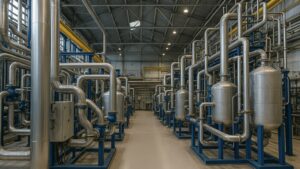Today, businesses face rising pressure to reduce their carbon footprint owing to increasing climate change. Scope 3 emissions. These are the indirect emissions occurring through the value chain of a company accounting majority of the footprint. One of the major considerations to reduce this footprint should be product and packaging as they contribute a large share. So, using recycled or renewable materials comes out as a viable solution. This article dives into how companies can reduce their Scope 3 emissions. This is from a change to recycled or renewable materials. So, let’s dive in.
Scope 3 Emissions: Understanding the Carbon Impact of Materials
When it comes to businesses, they obtain a lot of raw materials from non-renewable sources. As a result, it becomes a major source of emissions. Carbon emissions result from burning fossil fuels to make common products. It includes plastic, metal, glass, and paper. Moreover, high energy consumption during the production of these materials leads to more carbon footprint.
So, when supplied non-sustainable, even resources like lumber can be carbon intensive, leading to deforestation. As a result, business must carefully check their supply chains to see major issues and see where improvements can be made for scope 3 emissions reductions.
Calculating Cradle-to-Gate Emissions
Companies must oversee the emissions from the start of a product’s existence. It should be to the point where it is ready to use. It helps to understand better the carbon effects of a material. Tools for life cycle assessments and environmental product declarations are also useful when it comes to the examination. Many manufacturers of materials offer EPDs for buyers to review.
Businesses may also measure emissions at every stage of the production of a product or material. They can use software tools to conduct comprehensive life cycle assessments. Moreover, even though it requires a lot of resources, this is crucial. It helps identify the largest emission issues in a company’s material procurement. Additionally, it directs them to utilize low-carbon suppliers and commodities.
Recycled Materials For Scope 3
Promoting circularity and the use of recycled materials is emerging as a powerful way for companies to significantly reduce the Scope 3 emissions associated with purchased goods and services. Organizations can eliminate or reduce many of the embedded emissions. This is from resource extraction and initial material processing stages. They can reuse and reprocess discarded items and waste streams into recycled inputs instead of extracting virgin raw materials,
Benefits of Recycled Inputs
Using recycled materials for scope 3 offers several key advantages in curbing embodied carbon emissions:
- Avoiding emissions from extracting and initially processing virgin raw materials. It includes metals, plastics, and wood pulp
- Requiring less energy and emissions-intensive processes compared to manufacturing from virgin sources
- Cutting down on waste that would otherwise be burned or dumped in landfills. Furthermore, it helps to stop the production of dangerous climate gases like methane
Research indicates that when compared to their virgin equivalents, recycled materials might have much lower embodied emissions. For instance, only around 5% of the emissions produced during the production of new aluminum come from recycled aluminum. Similarly, the embodied emissions of recycled plastics are reduced by 30–60%. Furthermore, the carbon footprint of recycled paper is more than 50% lower than that of virgin paper sources.
In addition to lowering emissions, using more recycled materials in production may boost employment. It can also lessen reliance on scarce natural resources. Additionally, it can cut down on inefficient disposal methods, and save businesses money. Hence, it is a major factor in the shift to a more sustainable and circular economic paradigm.
Recycling Challenges and Innovations
Recycling has obvious environmental advantages. However, there are still some embedded carbon consequences. This is from the process that needs to be carefully considered and optimized. Recycling materials require energy for their collection, transportation, and sorting. They also need energy for their conversion into recycled inputs. It may be utilized in manufacturing. It includes recycled plastic pellets or metal sheets.
Furthermore, typical problems such as inappropriate disposal contaminating recycling streams and the shortcomings of existing recycling technologies in efficiently recovering and processing complex products or composite materials can reduce the amount of emissions saved and the feasibility of recycling some materials economically.
However, the recycling industry is rapidly innovating to enhance efficiencies and overcome hurdles:
- Robotics with artificial intelligence (AI) capabilities for automated sorting. it can boost recycling rates and sorting accuracy.
- Plastics that were formerly unrecyclable may now be broken down into chemical building blocks. This is for repolymerization into recycled resins thanks to advanced recycling methods. It includes chemical recycling and depolymerization.
- Contamination problems are decreasing as a result of manufacturers’ improved design for recyclability and improved labeling regulations.
- Creating new applications that can withstand inputs of recycled materials with reduced purity. It includes construction or automotive plastic components.
So, as these innovations are scaled, the emissions avoidance potential of recycling will continue growing across more material types.
Tapping Into Renewable Material Sources
While maximizing recycling is crucial, reducing the need for virgin material inputs in the first place by leveraging renewable alternatives is another priority for reining in Scope 3 emissions. An array of innovative bio-based and renewable materials for scope 3 are emerging as more sustainable substitutes. This is for conventional plastics, chemicals, and fibers derived from fossil fuels.
The Potential of Bio-Based Materials
Beyond plastics, developments in the manufacture of fibers are opening the door to the possibility of replacing emissions-intensive materials. It includes traditional cotton. It accounts for 0.3% of world emissions, with sustainable textile alternatives. Examples include:
- Leather substitutes developed from mycelium (mushroom root networks),
- Textiles created from agricultural wastes like banana and pineapple fibers,
- And garments made from bacterial and algal cellulose.
The majority of these developing bio-based materials still have rather narrow uses while providing sustainability benefits over traditional inputs. Furthermore, lifecycle assessments must be used to carefully evaluate any possible problems. This is with sustainable feedstock procurement, land-use implications, end-of-life processing, and also other related concerns.
However, if prices decrease and performance increases, bio-based materials may contribute significantly to the decarbonization of several sectors. It includes consumer products, packaging, and fashion. Moreover, their regenerative nature offers a means of severing the production process. This is from limited fossil carbon sources and the corresponding Scope 3 emissions.
Renewable Chemicals and Materials
Utilizing green chemistry and biotechnology to create sustainable chemical building blocks and products from plant-based feedstocks rather than fossil fuels is another exciting frontier. The goal of the developing renewable chemicals sector is to offer long-term substitutes for plastics. It also offers substitutes for traditional chemicals and other products derived from hydrocarbons.
For instance, entrepreneurs are creating bio-based processes. It transforms bioethanol or bio-based methane into “green” ethylene. It is a crucial feedstock for the production of plastics. After that, bioethylene may be polymerized to create renewable plastic resins. This is with a smaller carbon footprint than their fossil fuel-based counterparts, such as polyethylene.
For sustainable versions of various material inputs such as synthetic rubbers, lubricants, solvents, industrial gases, and more, similar bio-based manufacturing paths are being developed. Manufacturers will have easier access to sustainable, lower-emission substitutes for traditional material inputs as this industry develops. So, it will help to lessen the effects of Scope 3 emissions.
Sustainable Forestry and Agricultural Residues
Plant and forestry-derived materials will remain valuable sources of renewable energy for a variety of uses. Moreover, responsible and approved procurement is essential. It guarantees that these bio-based products avoid unforeseen repercussions. This includes biodiversity loss and deforestation. It might offset their benefits of reducing emissions.
Sourcing from sustainable forestry initiatives working to restore and responsibly manage forests delivers renewable wood and plant fiber inputs. This is while supporting ecosystem conservation and carbon sequestration. It includes sustainable construction materials like cross-laminated timber (CLT) and also bamboo products.
Similarly, the use of agricultural residues and byproducts that would otherwise be discarded, burned, or left to decompose offers a way to derive value-added materials without further land-use burdens. Examples include:
- Using wheat straw and other crop residues for paper and packaging materials to displace wood pulp inputs
- Extracting natural fibers like hemp for use in textiles and composites
- Organic cotton cultivation that avoids the emissions from synthetic fertilizer use
By combining increased recycling with scaled adoption of verified renewable and sustainably sourced bio-based inputs, companies can steadily decouple their material requirements from virgin fossil-derived sources. It is a critical lever for mitigating Scope 3 emissions over the long term.
Assessing Tradeoffs and Prioritizing Materials
While recycled and renewable materials for scope 3 hold immense promise, companies must still carefully assess potential tradeoffs and unintended consequences. These could undermine their Scope 3 emissions mitigation efforts. So, a comprehensive lifecycle perspective is in need. It avoids just shifting environmental burdens to other impact areas while ostensibly reducing embodied carbon.
Avoiding Burden Shifting
The end-of-life stage for some bio-based plastics may have higher emissions. This is from techniques like industrial composting compared to conventional plastic disposal. Some recycling processes like recycled paper production can generate other environmental impacts. It includes eutrophication and toxicity that must be managed.
There are also potential risks around material health and safety that require scrutiny. It covers concerns over the presence of legacy additives and contaminants finding their way into recycling streams. Moreover, exposure risks for workers and end consumers necessitate robust testing and monitoring.
That’s why comprehensive, third-party reviewed lifecycle assessments (LCAs) evaluating all environmental tradeoffs are crucial when vetting recycled and renewable material alternatives. Additionally, only by taking a holistic view can companies ensure their material choices truly align with circular principles and drive overall impact reduction.
Circularity and Designing for Recyclability
Products themselves must be designed for circularity and recyclability from the start using eco-design principles. It maximizes the emissions reduction potential of recycled and renewable inputs over multiple life cycles
This means prioritizing concepts like:
- Design for disassembly to easily recover materials,
- Using detachable components made from recycled materials compatible with recycling systems,
- And eliminating toxic substances or composites that contaminate recycling streams.
Companies like Dell have embraced circularity principles. It ensures the majority of their product portfolio incorporates recycled materials. This is while focusing on designing products optimized for refurbishment, reuse, and recycling. Moreover, the interface offers modular and recyclable carpet tiles made from recycled fishing nets and bio-based sources.
Such circular design approaches enhance the emissions avoidance potential of recycled and renewable inputs by enabling perpetual recycling. It also facilitates material health evaluations and transition to safer chemistry over time.
Prioritizing a Strategic Materials Approach
Given the diversity and rapidly evolving landscape of recycled and renewable material sources, companies need robust processes to systematically evaluate, prioritize, and set strategic interventions.
This often begins with comprehensive materiality assessments to identify the most emissions-intensive and high-impact material categories based on factors like:
- Scale and availability of recycled/renewable sources
- Potential emissions reduction and circularity enhancement
- Technical and economic viability
- Performance requirements and constraints
- Supply risks and geographic variance
Cross-functional teams can then collaborate with suppliers, recyclers, and material scientists. This is to determine appropriate substitutions with conventional inputs based on the assessments. Additionally, supplier engagement, innovation challenges, and partnerships become critical for piloting and scaling viable solutions.
Leading companies lay out clear supplier codes of conduct and materials policies with targets and timelines. It helps to transition to recycled content. This also helps in sustainable bio-based inputs and optimizing for circularity. Moreover, they align R&D and procurement activities towards these material strategies. This is while engaging customers to bring them along in the journey.
To Sum Up
Slashing Scope 3 emissions is a daunting challenge. However, leveraging recycled and renewable material inputs provides a high-impact opportunity. Whether recycled plastics, metals, paper, or the latest bio-based polymer innovations, sustainable material choices offer a way to decouple purchased goods from egregious embodied carbon impacts. However, maximizing their potential requires lifecycle thinking, eco-design for circularity, and strategic supplier engagement.
The 2nd Scope 3 Emission Reduction Summit in Berlin, Germany on April 18-19, 2024 arrives at a crucial time to accelerate this transition. Through cross-industry learning and invaluable networking, this pioneering event equips you with the latest strategies, solutions, and partnerships to initiate Scope 3 reductions. So, secure your spot to access vital guidance on using sustainable materials as a high-impact lever for shrinking your organization’s value chain emissions.





